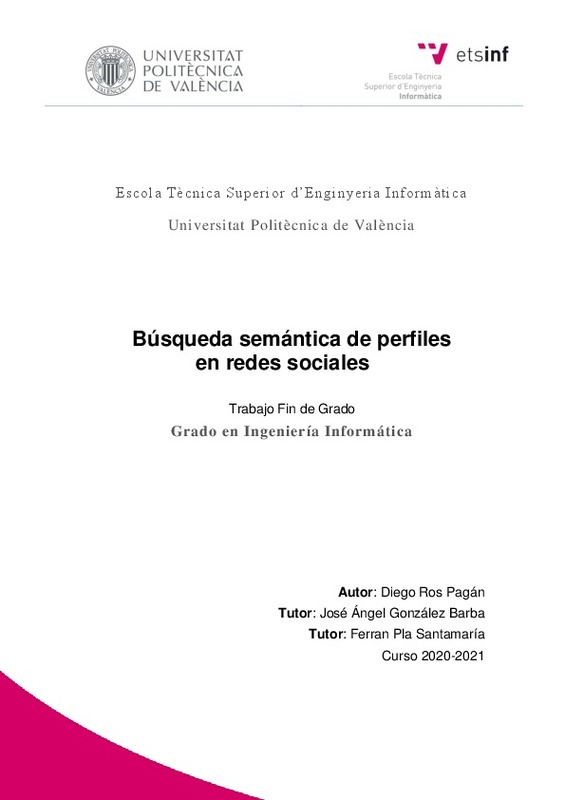JavaScript is disabled for your browser. Some features of this site may not work without it.
Buscar en RiuNet
Listar
Mi cuenta
Estadísticas
Ayuda RiuNet
Admin. UPV
Búsqueda semántica de perfiles en redes sociales
Mostrar el registro sencillo del ítem
Ficheros en el ítem
| dc.contributor.advisor | Pla Santamaría, Ferran
|
es_ES |
| dc.contributor.advisor | González Barba, José Ángel
|
es_ES |
| dc.contributor.author | Ros Pagan, Diego
|
es_ES |
| dc.date.accessioned | 2021-04-20T09:29:31Z | |
| dc.date.available | 2021-04-20T09:29:31Z | |
| dc.date.created | 2021-03-29 | |
| dc.date.issued | 2021-04-20 | es_ES |
| dc.identifier.uri | http://hdl.handle.net/10251/165365 | |
| dc.description.abstract | [ES] En este proyecto se ha desarrollado una aplicación que permite identificar la temática predominante en usuarios de la red social Twitter mediante el análisis del contenido textual generado por el usuario atendiendo principalmente a las relaciones semánticas que presentan los textos. Se utiliza un algoritmo de clasificación basado en word embeddings, en concreto se usa un modelo preentrenado Word2Vec para calcular la distancia semántica entre los temas, cuentas y tweets. El proyecto se centra en la red social Twitter, utilizando los tweets como la unidad básica a clasificar. Mediante un conjunto semilla de cuentas etiquetadas manualmente por temática se crea un modelo de representación vectorial. El modelo está creado en función de las representaciones de las cuentas en las que predominan dichos temas. Este modelado nos ha permitido crear una aplicación para clasificar cuentas de usuarios y tweets de forma automática en los temas considerados. | es_ES |
| dc.description.abstract | [EN] The objective of this project is to develop an application which will allow to identify the predominant topic in user profiles on Twitter social network. This is done by analysing the textual content generated by the users, mainly paying attention to the semantic relationships presented in the texts. A classification algorithm based on word embeddings is used. Concretely, a pre trained Word2Vec model is used to calculate the semantic distance between the topics, accounts and tweets. The project is focused within the Twitter social network, using tweets as the basic unit to be classified. By a seed set of accounts manually labelled by topic, a vector representation model is created. The model is created based on the representations of the accounts in which these topics predominate. This modelling allows us to create an application to classify user accounts and tweets automatically into the topics considered. | es_ES |
| dc.format.extent | 63 | es_ES |
| dc.language | Español | es_ES |
| dc.publisher | Universitat Politècnica de València | es_ES |
| dc.rights | Reconocimiento (by) | es_ES |
| dc.subject | Word embedding | es_ES |
| dc.subject | Word2Vec | es_ES |
| dc.subject | es_ES | |
| dc.subject | Clasificación semántica | es_ES |
| dc.subject | Semantic classification | es_ES |
| dc.subject.classification | LENGUAJES Y SISTEMAS INFORMATICOS | es_ES |
| dc.subject.other | Grado en Ingeniería Informática-Grau en Enginyeria Informàtica | es_ES |
| dc.title | Búsqueda semántica de perfiles en redes sociales | es_ES |
| dc.type | Proyecto/Trabajo fin de carrera/grado | es_ES |
| dc.rights.accessRights | Abierto | es_ES |
| dc.contributor.affiliation | Universitat Politècnica de València. Departamento de Sistemas Informáticos y Computación - Departament de Sistemes Informàtics i Computació | es_ES |
| dc.contributor.affiliation | Universitat Politècnica de València. Escola Tècnica Superior d'Enginyeria Informàtica | es_ES |
| dc.description.bibliographicCitation | Ros Pagan, D. (2021). Búsqueda semántica de perfiles en redes sociales. Universitat Politècnica de València. http://hdl.handle.net/10251/165365 | es_ES |
| dc.description.accrualMethod | TFGM | es_ES |
| dc.relation.pasarela | TFGM\130904 | es_ES |
Este ítem aparece en la(s) siguiente(s) colección(ones)
-
ETSINF - Trabajos académicos [5160]
Escola Tècnica Superior d'Enginyeria Informàtica






